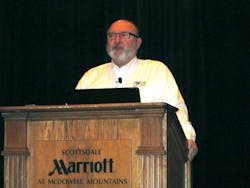It is definitely an interesting time to be attending an industrial communication protocol meeting. While at the PI International (Profibus/Profinet) General Assembly Meeting this week, I heard from a variety sources about the continuing surge in interest around all things Ethernet and wireless for the plant floor. And then came news about a possible merger of the HART Communication Foundation and the Fieldbus Foundation.
Beyond the anecdotal evidence surrounding the growth of Ethernet and wireless in industrial applications, representatives from four major industry suppliers spoke on the record about their support for Profinet in particular.
Noting that the number of installed Profinet nodes has quadrupled since 2008, despite the economic downturn, Raj Batra, president of the Industry Automation Division of Siemens, also cited Profinet’s ability to address three critical industry imperatives as principal reasons for Siemens ‘continuing support of the protocol. Those imperatives are:
• Efficiency—which includes using one cable for all purposes, delivery of device/network diagnostics, energy efficiency via ProfiEnergy, and proven ruggedness and stability;
• Performance—high speed and precision, high transmission rates, redundancy; and
• Flexibility—through offering of industrial wireless LAN, ProfiSafe safety protocol running on the same network, flexible topologies, expandability, and the open nature of the standard.
Batra also made note of BMW’s recent commitment to Profinet for the next 15 years and Fori Automation’s use of Profinet to integrate their automated guided vehicles’ control and safety systems to the company's production and ERP systems. Fori’s application of Profinet for AGV communications enabled the company to increase the number of AGVs in its plant carrying delicate materials—such as airplane wings—by 3x.
Darrell Halterman, GE’s Profinet product manager, cited a number of user examples of his own in support of GE’s preference for Profinet. In his first example of an automotive manufacturer that upgraded its 1990s era legacy serial distributed I/O to a Profinet backbone, Halterman said the manufacturer needed the Profinet network to support 150 variable frequency drives and 32 nodes of remote I/O. The manufacturer planned to make the switch to Profinet over a three-day weekend, with lots of contingency planning in place in case things went wrong. Instead of three days, the company was “painting cars again in six hours,” Halterman said.
Another of Halterman’s examples included an iron ore processing operation in Australia that sought to speed time-to-market for its product by creating a 24 km conveyor outfitted with remote distributed I/O every km. “Using Profinet with GE Intelligent Platforms’ RX3i PACs, VersaMax I/O, built-in Ethernet switches, and multimode fiber allowed point-to-point connection with no other external equipment needed,” he said.
The ability to collect “additional process values via digital communications tell you more about your plant and the devices in it than analog data can,” said Endress+Hauser’s Steffen Ochsenreither, marketing manager for fieldbus. The digital data and communications capabilities offered by Profibus allows users to “drive improved throughput, produce higher quality products and gather more reliable diagnostics while enabling bi-directional communications.”
Phoenix Contact supports Profinet because of its scalability and use in motion control and synchronous I/O applications, said Michael Rothwell, director of controls and industry solutions. Profinet’s support of standard TCP/IP along with I/O and control communication—to access all devices across one wire—is an important factor for Phoenix Contact. Other beneficial factors noted by Rothwell include:
• Profinet’s support for different topologies, media structures and wireless, thereby allowing the topology employed to follow machine layout;
• Profinet’s ability to integrate subsystems designed for other protocols, such as Interbus; and
• Device-independent diagnostics.


